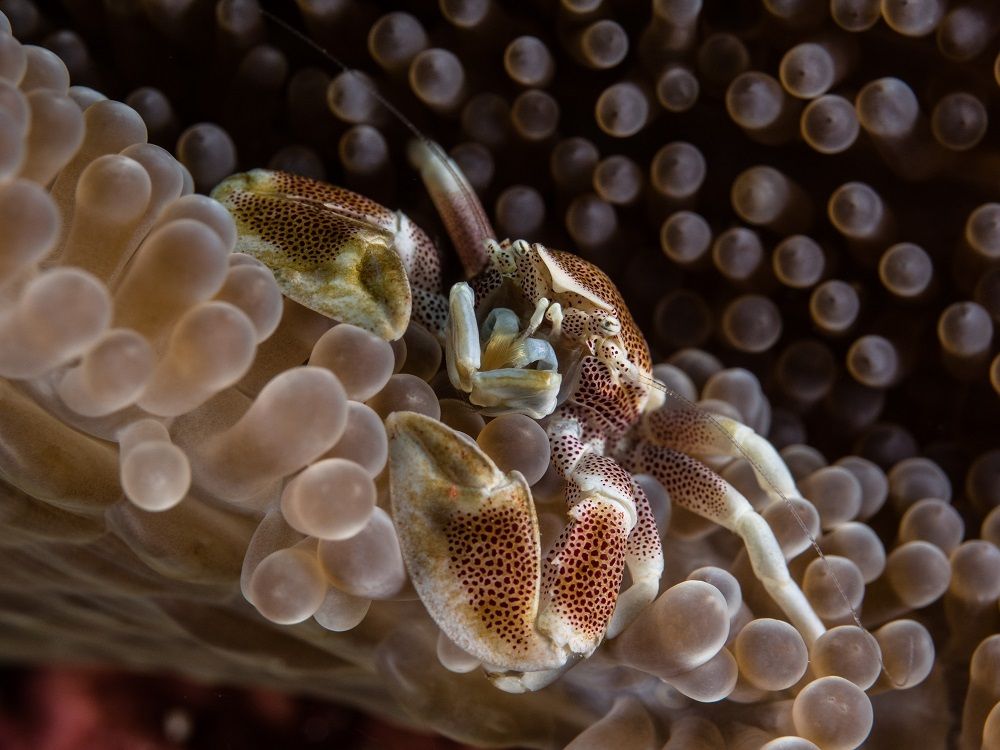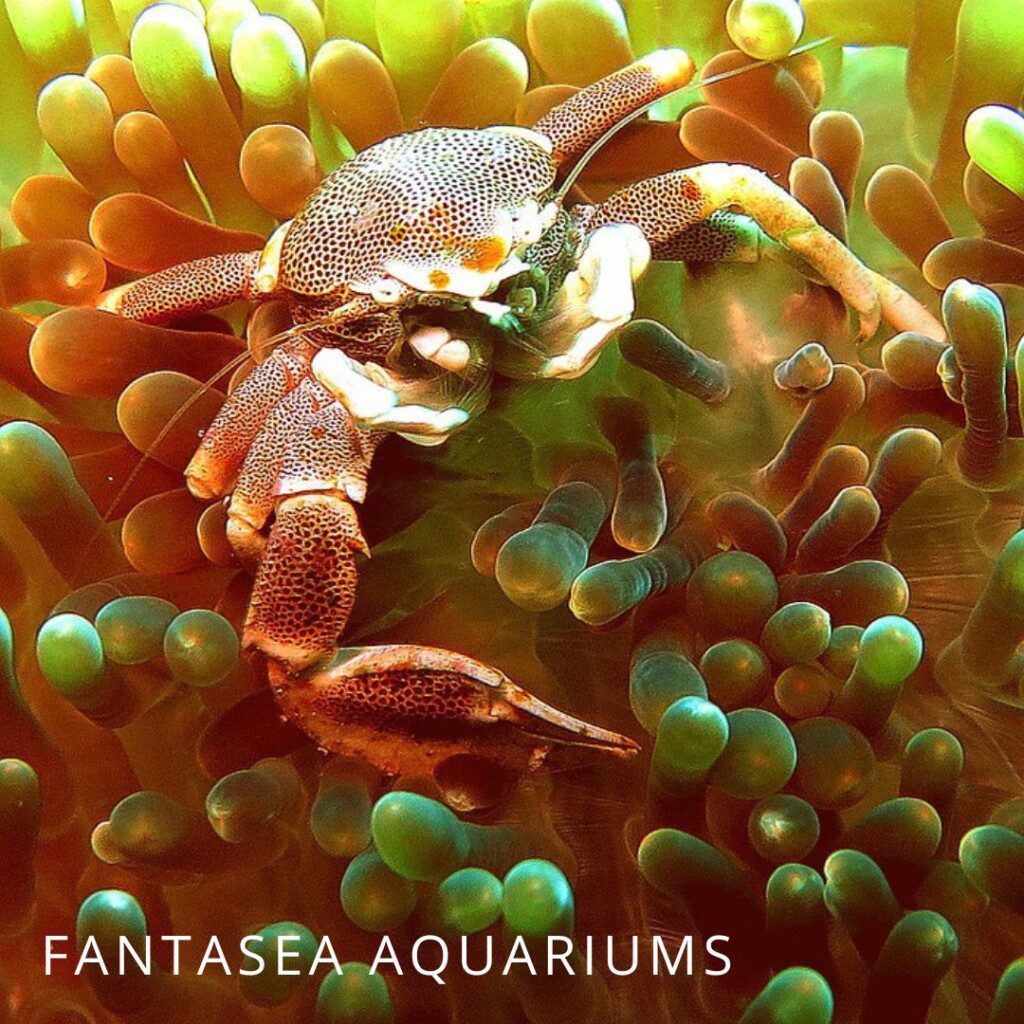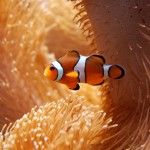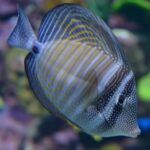Looking for a fun crustacean to add to your reef aquarium? Or trying to choose the right inhabitants for a nano saltwater set-up? The porcelain anemone crab may just be the perfect species for your tank! Reef-safe and docile, these anemone dwellers are one of the more well-behaved crab species for the aquarium.
Keep reading for everything you need to know about the porcelain anemone crab!
| Name (Common, Scientific) | Porcelain anemone crab, spotted porcelain crab, anemone crab, Neopetrolisthes maculatus (synonym: Neopetrolisthes ohshimai) |
| Minimum tank size | 10 gallons |
| Minimum group size | 1 (though a pair is preferable) |
| Temperature | 75-82 °F |
| Salinity | 1.020-1.025 |
| pH | 8.1-8.4 |
| Difficulty level | Easy |
Porcelain anemone crab (Neopetrolisthes maculatus) description & natural habitat
Description
One of the main reasons aquarists keep the spotted anemone crab (a member of the family Porcellanidae) is because of its appearance. The species is a perfect combination of wacky and beautiful to look at, with oversized, flattened pincers (mean to settle territorial disputes) and an off-white body covered in leopard spots (for camouflage). The actual spot pattern can vary according to location, which has led to some discussion about whether this is a single species or if Neopetrolisthes maculatus and its synonym ohshimai are actually two different crabs.
The species grows to a maximum size of around 3″, including the legs, and uses modified appendages with large filter fans to catch its food. Interestingly, unlike many other similar crustaceans, it only uses three out of its four pairs of legs to move around.
Did you know? Despite what its name suggests, the porcelain anemone isn’t actually technically a true crab. They’re actually more closely related to squat lobsters. This is one of the multiple examples of what is sometimes called carcinisation: when a crustacean that is not actually a crab eventually evolves to look like one. Apparently the crab shape is just a very effective one for crustaceans.
Mitochondrial gene rearrangements confirm the parallel evolution of the crab-like form
Natural habitat
The porcelain anemone crab is naturally found in temperate and tropical zones in the Indo-Pacific oceans, meaning it can be found all the way from eastern Africa to Australia and beyond. They prefer shallow, coastal reefs with fields of carpet anemones.
Like many other ocean dwellers (like the watchman goby and clownfish), this crab species maintains a symbiotic relationship with another creature. More specifically, they partner with anemones of the genus Stichodactyla, which also happen to be Nemo’s favorite host. Both parties benefit: the crab is protected by the anemone’s stinging tentacles and can use it as a foraging zone, while the anemone is kept clean.
Porcelain anemone crab (Neopetrolisthes maculatus) aquarium
This species isn’t too fussy about its environment, as long as the aquarium is fully cycled with no traces of ammonia and nitrite, and the water quality is kept high. You can keep a pair in an invertebrate-only aquarium from 10 gallons or up, making the porcelain anemone crab a great choice for nano tanks.
The most important factor is the host anemone. Sure, a porcelain anemone crab doesn’t technically need an anemone host, but we feel it’s worth the effort of cultivating an anemone for yours, just to be able to see their natural behavior. They simply seem very lost without a host! The most natural choice would be a Stichodactyla (carpet) anemone, but unfortunately these aren’t the easiest to keep alive.
Luckily, these crabs have also been reported to accept other anemones, so you can choose a species that suits your tank. The popular rainbow bubble tip anemone is an option, as are a good few others. Try placing the anemone in a spot that gets plenty of water flow. This way both it and the crab will be able to catch any floating particles in the water column.
Porcelain anemone crab (Neopetrolisthes maculatus) compatibility
Despite their large claws, porcelain anemone crabs are actually slow-moving, peaceful filter feeders that mostly rely on the safety of their anemone for protection. The most damage they do is during the occasional non-fatal territorial dispute, when something like a clownfish or other porcelain anemone crab gets a bit too close for comfort.
Its natural symbiotic relationship with anemones, as well as its filter-feeding habits, mean the porcelain anemone crab is fully reef safe. It also won’t bother tankmates, including the smaller ones, but may not do well if surrounded by large and boisterous fish. The species fits better into a peaceful community set-up. Don’t forget to buy yours in a pair, as that’s how they naturally occur!
If you’d like to keep things invert-only, consider the calmer species on our lists of aquarium crabs and aquarium shrimp. In terms of fish, steer clear of aggressive species and definitely avoid clownfish. As cute as Nemo is, he’ll bully your porcelain anemone crabs relentlessly in an attempt to take control of the anemone! Small, peaceful fish work best.
Did you know? When under attack, the crab will often opt for autotomy – dropping one of its limbs like a lizard would with its tail – rather than defending itself. They can be quite sensitive, with one study calling the behavior “hair-trigger”, so leave your porcelain anemone crab alone if you don’t want it to start dropping legs left right and center.
Porcelain anemone crab (Neopetrolisthes maculatus) diet
As their fan-like appendages suggest, porcelain anemone crabs feed on small particles and plankton that they filter from the water column. They’ll also eat a special mucus excreted from the anemone, as well as any particles that may be hiding between the tentacles. It’s quite fun to watch them forage!
Our home aquariums are usually too small and clean to sustain a porcelain anemone crab, and the water flow doesn’t tend to be strong enough either for particles to reach their fans. Supplemental feedings will be needed to keep yours well-fed. You can offer a range of small foods: these guys are not fussy.
Try feeding some thawed frozen food, crushed fish flakes or spirulina by releasing it near the filtering crab. This way, it can either catch the particles in its fans or go scavenging for them using its claws.
Breeding porcelain anemone crab
The one downside we see with this species is that Neopetrolisthes maculatus is always wild-caught. This is a practice we’re not huge fans of, but unfortunately, an alternative hasn’t been found so far! Breeding porcelain anemone crabs has proven quite the challenge and we haven’t heard of any successful breeding reports so far.
The issue mainly lies in the fact that this species produces larvae (zoae), which are exceedingly tiny and easy to kill. The larvae, which hatch by the hundreds from small eggs that the female incubates below her abdomen, naturally pass through multiple different stages of development before turning into tiny copies of the adults.
Unfortunately, in aquaculture, they always die off before being able to metamorphose.
Conclusion
Neopetrolisthes maculatus is a decorative, peaceful and reef safe species for the marine aquarium. You’ll enjoy watching your porcelain anemone crab going about its business filter feeding and scavenging for morsels in its anemone. Remember that these guys are pretty shy, so don’t worry if you don’t see yours for a bit!
A beautiful reef aquarium filled with host anemones and their porcelain anemone crabs is a fantastic addition to any home or office, but what if you lack the time or expertise to set up and maintain one? That’s where we come in! Feel free to contact FantaSEA Aquariums with your fish tank dreams and we’ll help you make them a reality.






